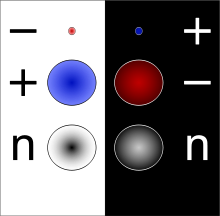ဆန့်ကျင်ဘက်အမှုန်
အမှုန်ရူပဗေဒတွင် အမှုန်အမျိုးအစားတိုင်းသည် တူညီသော ဒြပ်ထုနှင့် ဆန့်ကျင်ဘက်ဓာတ်ဆောင်သော ဆန့်ကျင်ဘက်အမှုန်နှင့် ဆက်နွယ်လျက်ရှိသည်။ ဥပမာ အီလက်ထရွန်၏ ဆန့်ကျင်ဘက်အမှုန်မှာ ပိုစီထရွန်ဖြစ်သည်။ ယင်းအား ဆန့်ကျင်ဘက်အီလက်ထရွန်ဟူ၍ ခေါ်ဆိုနိုင်သည်။ အီလက်ထရွန်သည် လျှပ်စစ်အမဓာတ်ဆောင်ပြီး ပိုစီထရွန်သည် လျှပ်စစ်အဖိုဓာတ်ဆောင်ပြီး ရေဒီယိုသတ္တိကြွပြိုကွဲမှုအမျိုးအစားအချို့တွင် သဘာဝအတိုင်း ထုတ်လွှတ်သည်။ ထိုနည်းအတိုင်းပင် ပိုစီထရွန်၏ ဆန့်ကျင်ဘက်အမှုန်မှာ အီလက်ထရွန်ဖြစ်သည်။

ကိုးကား
ပြင်ဆင်ရန်- Feynman၊ R. P. (1987)။ "The reason for antiparticles"။ in R. P. Feynman; S. Weinberg (eds.)။ The 1986 Dirac memorial lectures။ Cambridge University Press။ ISBN 0-521-34000-4။
- Weinberg၊ S. (1995)။ The Quantum Theory of Fields, Volume 1: Foundations။ Cambridge University Press။ ISBN 0-521-55001-7။
| ဤ ရူပဗေဒနှင့် သက်ဆိုင်သော ဆောင်းပါးမှာ ဆောင်းပါးတိုတစ်ပုဒ် ဖြစ်သည်။ ဖြည့်စွက်ရေးသားခြင်းဖြင့် မြန်မာဝီကီပီးဒီးယားကို ကူညီပါ။ |